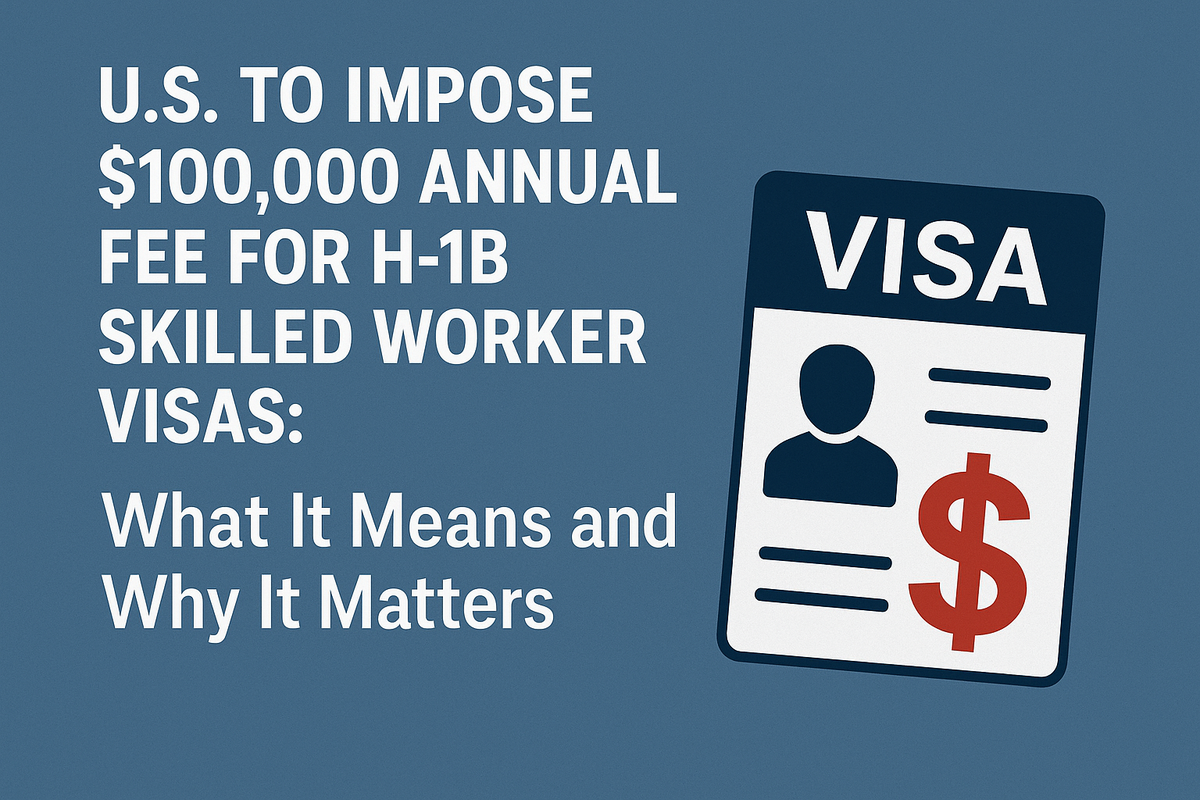U.S. to Impose $100,000 Annual Fee for H-1B Skilled Worker Visas: What It Means and Why It Matters
Published: September 20, 2025 — By Muhammad Arbaz Bashir
In a major change to U.S. immigration policy, the administration announced a proclamation instituting a $100,000 annual fee on H-1B visas for skilled foreign workers. The measure aims to limit perceived abuses of the program and protect American workers — but it raises urgent questions about innovation, workforce supply, and the future of U.S. competitiveness.
What exactly is changing?
The H-1B program has long allowed U.S. employers to sponsor skilled foreign workers in occupations that typically require a bachelor’s degree or higher. Under the new proclamation, employers filing new H-1B petitions will be required to pay a $100,000 fee per sponsored worker per year. This fee is in addition to existing filing and administrative fees, and it dramatically raises the cost of hiring foreign skilled labor through the H-1B route.
- The fee applies to new H-1B petitions and must be documented at filing.
- Some discretionary carve-outs are available for cases deemed in the national interest.
- The proclamation is initially set for a fixed period (for example, 12 months) but could be extended or revised.
Why was this policy proposed?
The administration frames the fee as a corrective measure designed to address several concerns:
- Protect American jobs: Some employers use H-1B hires to fill roles that could go to U.S. graduates, or to drive down wages in entry-level positions.
- Reduce program abuse: Critics point to outsourcing models and contract staffing firms that sponsor large numbers of workers to lower labor costs.
- Encourage domestic hiring and training: By increasing the marginal cost of hiring overseas talent, the policy aims to nudge employers toward investing in U.S. workforce development.
There is also a political dimension: immigration policy often serves as a signal to certain voter groups that the government is prioritizing domestic employment.
Immediate impacts: who wins and who loses?
Potential winners
- Qualified U.S. graduates: Reduced competition for certain early-career roles could favor newly graduated Americans, especially in STEM fields.
- Large incumbents able to absorb costs: Firms with large margins or entrenched revenue models might pay the fee while continuing to hire top global talent.
- Political constituencies: Groups prioritizing protection of domestic labor markets may view the policy as a win.
Likely losers
- Foreign early-career professionals: Junior hires and those sponsored by small employers may be priced out of U.S. opportunities.
- Startups and scaleups: Smaller firms that rely on foreign talent to scale quickly could face prohibitive hiring costs.
- Academic and research institutions: Universities and labs that attract global researchers may see reduced access to talent.
Economic and innovation risks
The U.S. technology and research ecosystem depends heavily on international talent. A sudden, high barrier to entry creates several risks:
- Talent gap and slower growth: Companies may struggle to fill specialized roles, delaying product development and innovation.
- Offshoring and remote work: Faced with higher U.S. hiring costs, some firms may relocate projects offshore or permanently hire remote teams abroad.
- Reduced competitiveness: Where other countries offer smoother immigration paths, global talent could choose alternatives like Canada, EU nations, Singapore, or Australia.
Compliance, carve-outs, and legal questions
Several operational and legal questions will determine how the policy plays out:
- How strictly will exemptions be applied? The proclamation mentions discretionary carve-outs for national interest cases, but the implementation details matter.
- Who pays the fee? The rule requires employer payment, but firms may pass costs to projects or restructure hiring models.
- Judicial and legislative scrutiny: Because immigration authority is complex and often requires congressional action, the proclamation could face lawsuits or calls for legislative review.
How employers might respond
- Absorb costs selectively: Large firms with deep pockets might continue hiring the most critical foreign talent and pay the fee as a cost of doing business.
- Hire locally or invest in training: Firms may increase internships, apprenticeships, and graduate hiring to build domestic pipelines.
- Shift to remote/global teams: Rather than sponsoring H-1B visas, employers may hire remote developers abroad, which avoids the fee but changes workforce distribution.
Longer-term geopolitical and labor effects
Removing or significantly restricting access to the H-1B pathway changes global talent flows. Countries with friendlier immigration and startup policies could gain a relative advantage in attracting the world’s best engineers and researchers. In the long run, these shifts may affect where companies choose to found startups, invest in R&D, and hire leadership talent.
What to watch next
- Implementation rules: The exact procedural details on fee collection and exemptions will determine immediate impact.
- Industry response: Will major companies or associations file litigation or lobby Congress?
- Visa volumes: Will H-1B petition filings drop dramatically, or will employers absorb the cost?
- International reaction: Will partner countries respond or negotiate changes?
Conclusion
The $100,000 H-1B fee is a striking and consequential policy — one that aims to reform how the U.S. admits skilled foreign labor but that also risks unintended harm to innovation, startups, and research. For employers, foreign professionals, and policymakers, the next few months will be crucial as implementation details, exemptions, and legal challenges unfold.
If you are an employer, HR leader, or foreign professional affected by this change, now is the time to review hiring strategies, consult immigration counsel, and consider alternatives such as remote talent models, investment in domestic training, or exploring other immigration pathways.
Author: Muhammad Arbaz Bashir — LinkedIn
Tags: H-1B, immigration, tech industry, visas, Trump, workforce policy



